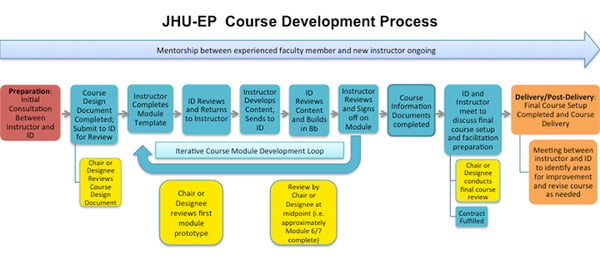Published on
Letting the Tiger Loose: Collaborating to Transform Online Course Design

Who better to re-engineer a process than engineers? In April 2014, the Center for Learning Design and Technology (CLDT) at Johns Hopkins Engineering for Professionals formed a “Tiger Team” (it’s an approach often used in the engineering field) of engineering faculty, CLDT staff, administrators and an external consultant to conduct a thorough review of CLDT’s online course development process in order to identify ways to optimize the process. The Tiger Team faculty members brought a wealth of expertise in project management, human-systems engineering and process improvement, as well as experience in online course development. Typically, a Tiger Team is brought together to address a complex problem that needs to be resolved in a short amount of time. The Tiger Team approach was well-suited to the demanding professional commitments of the team members. The Tiger Team met over the course of two months on a weekly basis in the evenings for an hour and a half. All the work of the Tiger Team was conducted during those meetings.
Online programs at Johns Hopkins Engineering for Professionals have been steadily growing, creating an ever-increasing demand on the resources provided by the CLDT. We presently offer 10 online degrees with several more due to launch within the year. The CLDT staff, consisting of a director, assistant director, six full-time instructional designers and two full-time instructional technologists, is annually supporting 80+ new online course developments. CLDT uses a highly structured, high-touch approach to online course development. Each instructor is assigned an instructional designer who works with them from the beginning of the process through the course completion and often delivery.
One of the biggest challenges CLDT faces is a low course development completion rate. For example, of the 83 new online course developments initiated in FY15, only 26 finished, for a completion rate of 31 percent. This completion has a direct impact on the number of new online course developments CLDT’s instructional designers can support for each of the two development cohorts (fall and spring). One of the unique features of Johns Hopkins Engineering for Professionals—its reliance on using working professionals as instructors—also becomes a challenge when assigning them the task of developing an online course. The faculty are limited to doing the online development work either in the evenings or on weekends. Leading up to the Tiger Team, the online course development completion time was averaging 11 months.
The idea for the Tiger Team was initially proposed by the associate dean of Johns Hopkins Engineering for Professionals, Dr. Dexter G. Smith. He presented the following four goals for the team:
- Re-engineer the existing process to accelerate completion times (reducing them by 1/3)
- Design a process that motivates good classroom-based instructors to want to become high-quality online instructors
- Establish a highly collaborative relationship between the instructors and the CLDT team
- Reduce all barriers to success.
The Tiger Team took a relatively simplistic, but straightforward approach to meeting the team’s goals. Their approach consisted of establishing a baseline of CLDT’s current online course development, determining what was working and where there were chokepoints in the process, defining actions to fill the gaps between the current process and the new optimized process, and conceptualizing a re-engineered process.
The Tiger Team process was significantly enhanced by the use of large-scale diagrams of the existing process and the different iterations of the re-engineered process. Johns Hopkins Engineering for Professionals was fortunate to have access to a large blotter printer that allowed us to create these process diagrams that we then posted to the classroom’s whiteboards where we met. In approximately two months, the Tiger Team completed its task and the new re-engineered process was presented at the program chairs’ meeting in early June 2014.
One of the key features of the new re-engineered process involved program chair reviews at four different milestones over the duration of the development process. Other changes included the addition of course development mentors, replacement of facilitated training with “just-in-time” training, establishment of consulting/collaborative roles between faculty members and instructional designers early on, a simplified initial course design document, and the development of course module prototypes early in the development process. The final “product” of the Tiger Team is represented by the following graphic.
The new process has been in place for approximately a year. We won’t have completely cycled through the new process until the end of the 2015 fall cohort of developments, which begins in August and ends by January 2016. At that point, we’ll have a full years’ worth of data. However, we’ve been able to capture some preliminary data and the results look very encouraging. For those developments started since July 2014, the development completion time has gone from 11 months 18 days to 7 months 23 days for a 33 percent reduction, meeting Dr. Smith’s goal of reducing the development timeframe by a third.
Another positive outcome of this re-engineered process is the active involvement of the program chairs in the online course development process. As a result of their reviews, they believe the quality of the online courses has increased. Because many of the program chairs at Johns Hopkins Engineering for Professionals have developed online courses and teach online, they are now able to apply both their subject-matter expertise and practical online teaching experience to these course reviews.
As CLDT’s director, one of the most interesting perspectives learned from this process is the shift in focus from a process designed “for” faculty to a process designed “by” faculty. They are the “clients” or “customers” of CLDT. Having an opportunity to listen and learn what our constituents wanted really made a difference. We haven’t fixed all the problems, and we’ll always have the challenges of working with part-time faculty, but hopefully we won’t lose the perspective that the faculty are our clients and that it is our role to constantly be looking for ways to improve our service to them.
Author Perspective: Administrator




